- Home
- Resources
- Safe work procedures
- Cleanup and disposal
Asbestos
Cleanup and disposal
Asbestos waste and debris must be disposed of quickly and correctly to minimise any asbestos fibre exposure to the homeowners or workers.
Procedure for cleaning the work area
Carefully clean dust and debris form all horizontal surfaces (e.g. floor, window sills, and architraves) near the work area using either of the following two methods:
Method one: (wet wipe method)
Wet wipe method to clean dust and debris from the work area and horizontal surfaces using damp rags or disposable wipes. Then using a atomizer bottle mixed with a solution of PVA glue with a consistency of five parts water and one part glue (five to one). Spray the drop sheet to capture any missed residue and then fold the drop sheet on itself and dispose of as asbestos waste.
Follow the steps depicted below.
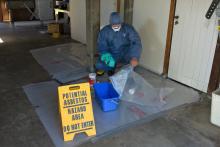
Step 1
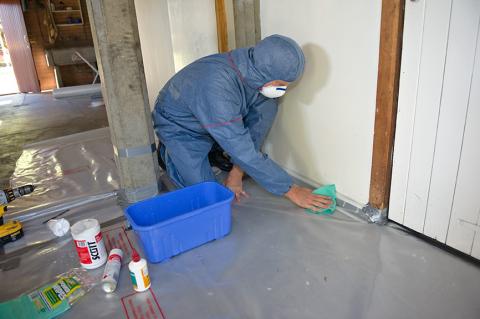
1. Wet wipe the surface below the work area.
Step 2
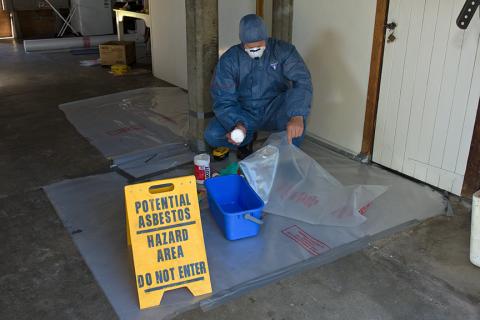
2. Once the area is cleaned and wipes are disposed of correctly into an approved asbestos waste bag or container, commence the removal of the protective floor covering.
Step 3
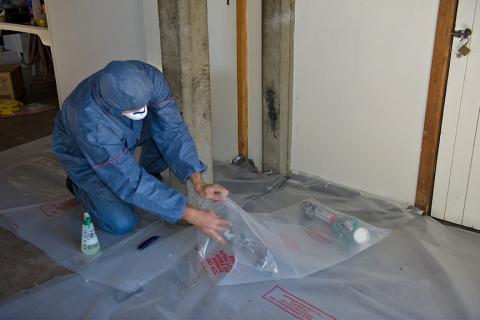
3. Disposing of the duct tape and wipes.
Step 4
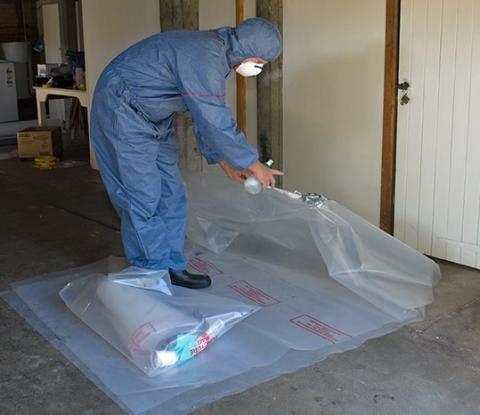
4. Carefully fold the plastic sheeting on it self, covering all previously exposed areas, and use as the last area of floor covering during the personal decontamination procedure.
Method two: (using a HEPA vacuum and wet wipe method)
Use an H rated industrial HEPA filter vacuum (that complies with AS/NZ 60335.2.69:2003 and AS4260-1997 for HEPA filtration) to control airborne fibres and dust to a HEPA filtered vacuum cleaner. When the vacuuming is completed then wet wipe the surfaces as mentioned in 'Method one'. Please note that a household vacuum cleaner must not be used because it is not designed for this type of work and will cause an uncontrolled release of asbestos fibres.
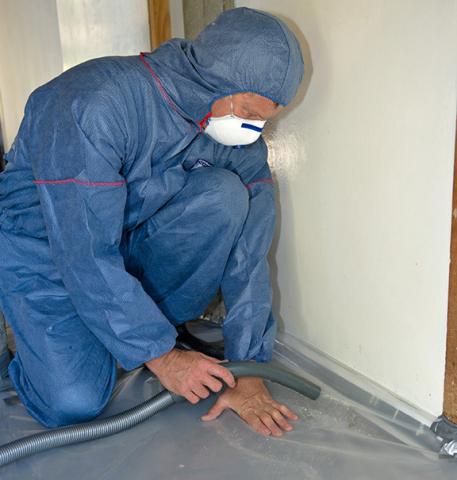
Using an H rated industrial HEPA filter vacuum to remove dust and debris.
View a film extract about Decontamination procedure, personal decontamination and cleanup procedures from Asbestos Awareness - an informative guide to asbestos.
Personal decontamination
Follow the steps depicted below and view the example video.
Step 1
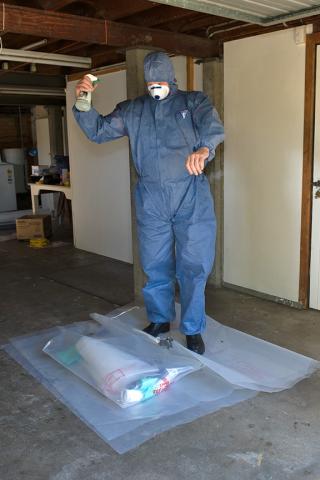
1. Use a spray bottle and water to wet down coveralls to capture any dust on the garment.
Step 2
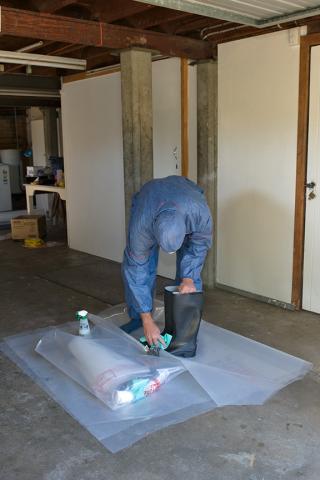
2. Wet wipe boots, including the bottom of the boots.
Step 3
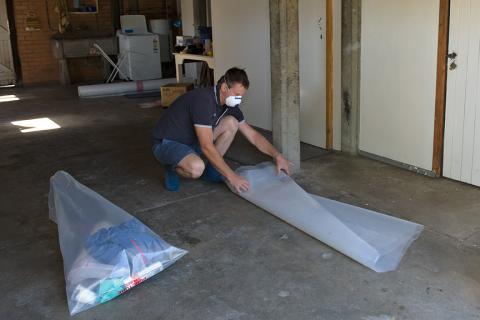
3. Place the coveralls in the approved waste bag. Place any equipment to be used again like gumboots, respirators and tools in a separate approved asbestos waste bag which is correctly labelled and seal inside another bag. This is for safe transport to any other asbestos work area. Then, fold up the plastic drop sheet and place it in the approved asbestos waste bag.
Step 4
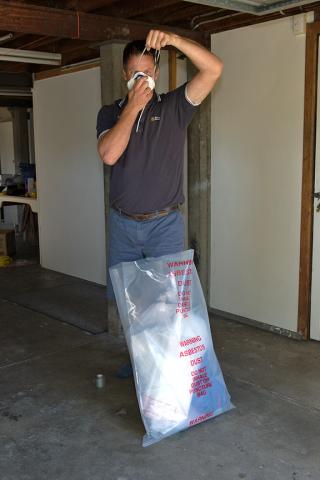
4. Wet down the disposable mask and remove only once all the other items are safely in the approved asbestos bag. Reusable respirators should be wet wiped and placed inside an approved asbestos waste bag or container for reuse at another asbestos work site.
Step 5
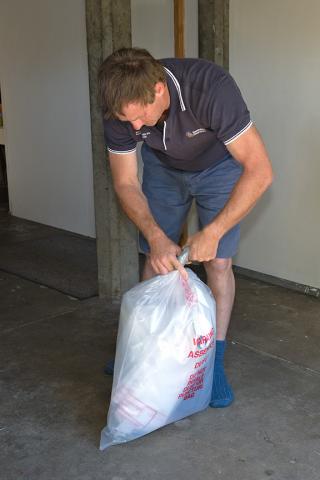
5. Expel some of the air in the disposal bag and then twist the neck of the bag whilst sealing the bag with duct tape.
Step 6
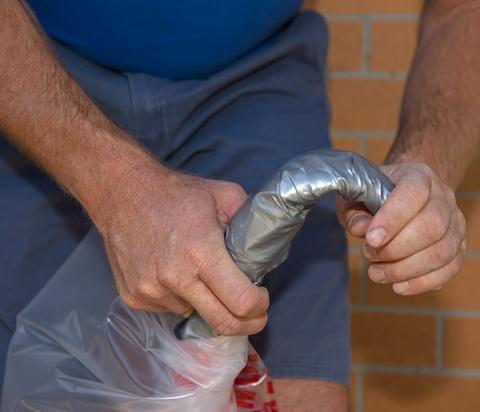
6. Once the neck of the bag is fully taped bend it over on itself.
Step 7
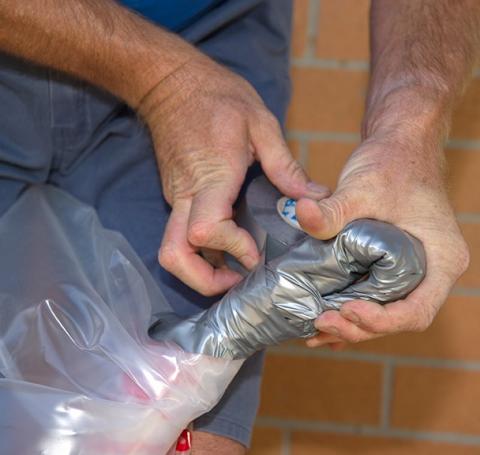
6. Once the neck of the bag is fully taped bend it over on itself.
Disposal of waste and clearance inspection of the work area
- Visually inspect the work area including all horizontal surfaces to ensure they are clear of all visible dust and debris. Air monitoring is not normally required for this task.
- Ensure that the work area is clean and tidy and all waste has been removed from site. No rubbish should remain on site after the work has been complete.
- Dispose of the waste in accordance with the local council requirements.
- Sign off any access permits and authority with the relevant person.
- Accompany the PCBU or site owner to inspect the site to confirm that the area is clean and tidy and that the work is completed.
- Home
- General information
- What is asbestos?
- How was asbestos used?
- Are there health effects?
- The risks of exposure
- Health monitoring
- Legislation and codes of practice
- Low density asbestos fibre board
- Asbestos contaminated dust or debris
- Fires
- Cleaning up after floods and storms
- Importation prohibited
- Government and agency roles
- Asbestos in government assets
- Know where asbestos is
- Removing or disturbing asbestos
- Practical guidance
- Resources
- Asbestos alerts
- Asbestos news
- Codes of practice
- Guidance
- Films
- Asbestos safety session 2021
- Asbestos safety session 2020
- Cleaning Asbestos Roofs
- Shadow vacuuming with a H-Class vacuum cleaner
- Use and maintenance of a H-Class vacuum cleaner
- Identifying low density asbestos fibre board hazards and risks
- Working safely with asbestos for the home renovator
- How to properly wear personal protective equipment for airborne contaminants
- Personal protective equipment
- Dear Dad - An asbestos awareness film
- Clear and present danger: Asbestos exposed
- Uses and applications of asbestos - an extract from a film by Parsons Brinckerhoff
- Asbestos health issues - an extract from a film by Parsons Brinckerhoff
- Safe work procedure - storm and wind damage cleanup
- Drilling into asbestos walls and ceilings
- Asbestos - Removing switchboard panels
- Decontamination procedure, personal decontamination and cleanup procedures
- Asbestos awareness
- Safe work procedures
- Preparation before commencing the task
- Preparing and painting corrugated asbestos cement roof and fences
- Drilling into non-friable asbestos using a thickened substance to control airborne fibres and dust
- Drilling into non-friable ACM using an H rated industrial HEPA filter vacuum to control airborne fibres and dust
- Removing a small package electrical switchboard
- Cleanup and disposal
- Safe cleanup of storm damaged materials that may contain asbestos
- Frequently asked questions for homeowners and the general public
- Podcasts
- Strategies
- Working Safely with Asbestos Guide
- Asbestos awareness week 2025
- Asbestos management compliance campaign
- Induction and safety training for unlicensed work
- Sanctions